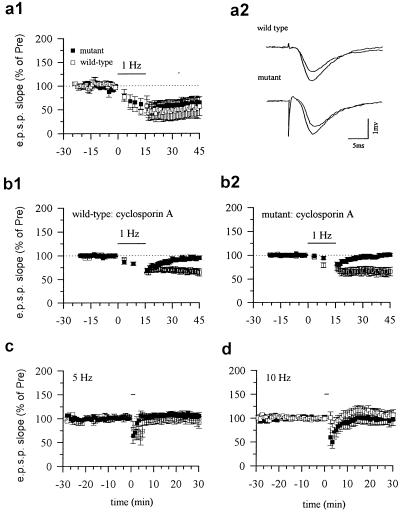Figure 2.
LTD is normal in calcineurin Aα mutant mice and is blocked by cyclosporin A. (a1) Low-frequency stimulation (1 Hz, 15 min) induced LTD in the CA1 region of the hippocampus from wild-type mice (open squares; 61.6 ± 9.4%, n = 14 slices/10 mice, t = 4.09, P < 0.01 comparing the potential 25 to 30 min after stimulation to the average of the potential before stimulation) or mutant mice (filled squares; 63.8 ± 12.0%, n = 9 slices from 5 mice, t = 3.02, P < 0.05). (a2) Representative recordings of the EPSP before and 30 min after low-frequency stimulation in wild-type (upper trace) and mutant (lower trace) mice. (b) LTD in wild-type and mutant mice was blocked by cyclosporin A. (b1) Pretreatment with cyclosporin A blocked LTD in wild-type mice (100.6 ± 4.0%, n = 6 slices/4 mice). LTD was not affected in vehicle-treated groups (open squares, 64.6 ± 0.5%, n = 6 slices/4 mice). (b2) Pretreatment with cyclosporin A blocked LTD in mutant mice (filled squares, 96.6 ± 5.1%, n = 6 slices/4 mice). LTD was not affected in vehicle-treated mutant mice (open squares, 64.5 ± 0.4%, n = 6 slices/5 mice). (c) Low-frequency stimulation at 5 Hz did not affect synaptic transmission. Neither LTP nor LTD was induced in wild-type (open squares, 94.5 ± 14.1%, n = 6 slices/6 mice) and mutant (filled squares, 103.9 ± 5.5%, n = 7 slices/7 mice) mice. (d) Stimulation at 10 Hz did not affect synaptic transmission. Ten-hertz stimulation produced neither potentiation nor depression in wild-type (open squares, 106.1 ± 9.7%, n = 11 slices/9 mice) or mutant (filled squares, 98.1 ± 13.0%, n = 8 slices/6 mice) mice.

